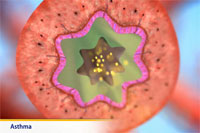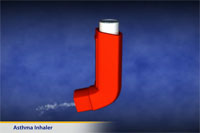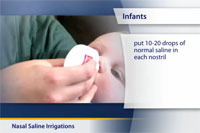
Asthma: Environmental Control
Children with asthma have unusually sensitive airways. Asthma symptoms can be triggered by many things in the environment. These triggers are unique to each child. Some common environmental triggers of asthma symptoms are cigarette smoke, pollens, house dust, molds, animal dander, perfume, strong odors, and cold air. Climate and weather changes can also affect asthma.
Try to limit your child's contact with these triggers, especially in places where your child spends a lot of time, such as at home and school.
Smoking
Cigarette, pipe, and cigar smoke are harmful to children and adults in general, but the smoke poses a special problem for all children with asthma. Even the smell of smoke on clothes can trigger asthma symptoms in a child with sensitive airways. No one should smoke in the home where an asthmatic child lives- even when the child is not present. Do not allow smoking in any cars that children ride in.
Pollens
Pollens are small particles that plants such as trees, grasses, and weeds release into the air. The amount of pollen in the air outdoors varies with the season and the time of day. Pollen and outdoor mold amounts tend to be lower in the early morning, and higher at midday and in the afternoon.
Pollens from grasses, weeds, and trees are light and can be carried in the air for miles. These pollens land in the eyes, nose, and airways, causing the symptoms of allergies and asthma. Flower pollens are heavier and are carried from plant to plant by insects rather than the wind. As a result, flower pollens rarely cause allergies. Although it is hard to avoid pollens completely, some suggestions are:
- Keep your windows shut (especially in your child's bedroom), and use central air conditioning during pollen seasons. If a room air conditioner is used, recirculate the indoor air rather than pulling air in from outside. Air purifiers can be helpful if filters are kept clean. HEPA (high efficiency particulate air) filters are best. Wash or change air filters once a month.
- After being outside during allergy season, your child should shower and change clothes right away. Do not keep the dirty clothes in bedrooms because there may be pollen on the clothes.
- Mow the lawn often. This limits the amount of pollen released. Your child should not be in the immediate area when the lawn is being mowed.
Molds
Molds are found year-round throughout the house, outdoors, and in foods, but especially in areas of high moisture. Molds blow around in the air both outdoors and indoors. Bathrooms and damp basements are common areas for mold growth. Mold is also very likely to grow in swamp coolers, humidifiers, and the refrigerator drip pan and crisper. Here are some ways to decrease mold growth:
- Light and ventilation prevent mold growth. In the bathroom, clean the tile, floors, shower curtain, and tub thoroughly and often. Also clean under the sink. Use a cleaning solution that kills molds. For example, you can use diluted household bleach (1 cup of bleach in 10 cups of water).
- Repair leaky faucets and pipes. Try to get rid of leaks and standing water.
- Use paint rather than wallpaper on your walls. Enamel paint stops mold growth better than latex paint. An antifungal substance can be added to paints to keep mold from growing.
- It is best to keep the humidity in the house between 30 and 50%. Buy a dehumidifier to take moisture out of the air if you live in a humid climate. Dehumidifiers can help keep mold from growing in damp areas such as basements. Look for areas that get damp from hard rains and fix any leaks that you find.
- Avoid evaporative coolers, vaporizers, and humidifiers with a reservoir, if you can, because they are ideal places for mold and bacteria to grow. When these appliances are operating, molds and bacteria can be sprayed throughout the house. If you do use one, empty the reservoir daily, clean it with soap and water, and dry it thoroughly. The reservoir should be refilled just before use.
- Greenhouses, compost piles, and homes with many plants also frequently have molds. Cover the potting soil of houseplants with foil to reduce the spread of mold spores.
House Dust
Many things are in house dust, including dirt, insect debris, dust mites, molds, animal dander, dead skin, food crumbs, and bacteria. Dust collects on every item in the home, including mattresses, couches, clothes, rugs, drapes, and stuffed animals. It is hard to avoid house dust, but the following ideas will help:
- Avoid clutter and dust catchers, particularly in the bedroom. These include knickknacks, wall decorations (pictures, pennants, and fabric wall coverings), drapes, shades or blinds, stacks of books, and piles of papers or toys.
- Give your child washable, "nonallergenic" stuffed toys when possible. For children who want to sleep with soft toys, keep only one or two soft toys in the bed, and wash them every week in hot water (at least 130° F). Store toys, dolls, and play equipment outside the bedroom or in the closet.
- Keep the bedroom closet door closed. Vacuum the closet floor often. Store only in-season clothes in the closet.
- Bare floors are best. You can replace carpet with washable, nonskid rugs. Damp mop the floors often. If you have carpet, vacuum often and thoroughly. Change vacuum cleaner filters often. Vacuum and dust early in the day to let dust settle before nap or bedtime. It is best to vacuum when your child is not home or to keep your child in another area of your home for 30 to 60 minutes after you vacuum. Be sure to clean under the furniture and in the closet.
- Mattresses should be in coverings that are allergen-proof, such as plastic. You can get allergen-proof coverings where bed linens are sold. Zippers or openings should be taped. Use only polyester pillows. Cover pillows with allergen-proof covers or wash the pillows each week in hot water. Also wash blankets, sheets, and pillowcases in very hot water (hotter than 130° F, or 54.4° C) every week. Cooler water used with detergent and bleach can also work. Avoid products made of feather, wool, kapok, or foam.
- Forced-air furnaces and air conditioners should have a dust-filtering system. Filters should be changed every 2 to 4 weeks. Filters can be cut to cover room vents if the central furnace filters are not changed every 2 weeks. Have cold and warm air ducts professionally cleaned at least every 4 to 5 years.
Pets
Allergens are found in animal saliva, dandruff, and urine. They cause allergic reactions in many people. Children may be more sensitive to one type of animal (such as cats) than another. All furry animals can cause allergic reactions. Cold-blooded reptiles, such as snakes, turtles, lizards, and fish, do not cause problems.
Giving away a family pet is very hard, but if your child is very sensitive, it may be necessary. Once the pet is gone, thoroughly clean the house. It is especially important to clean stuffed furniture, wall surfaces, rugs, drapes, and the heating/cooling system.
If your child is sensitive to animals and has a pet, the best thing is to remove the pet from your home. If this is not possible, the pet should live outside and NEVER be in the child's bedroom. Keep your child’s bedroom door closed. Keep pets out of family areas and rooms where people with asthma sleep at all times.
- Wash pets weekly.
- Wash hands immediately after any contact with a pet.
- Have non-allergic family members wash, brush, or comb pets, or clean out animal cages or litter boxes outdoors.
- Change furnace filters monthly.
Cockroaches
Cockroaches and their droppings are a major allergy trigger, and worsen asthma symptoms. To get rid of cockroaches:
- Keep food and garbage in containers with tight lids. Take garbage out often.
- Never leave food out. Especially keep it out of bedrooms. Do not leave out pet food or dirty food bowls.
- Vacuum or sweep the floor, wash the dishes, and wipe off countertops and the stove right after meals.
- Plug up cracks around the house to help stop cockroaches from getting in.
- Do not store paper bags, newspapers, or cardboard boxes.
- Use bait stations and other environmentally safe roach poisons.
Air pollution
Different types of indoor and outdoor air pollutants can aggravate asthma. This includes ozone, dust, smoke, paint fumes, and strong perfumes or odors. Weather conditions such as cold temperature and low humidity can make asthma worse, especially on high pollution days.
- Check news services for the daily pollution index (and pollen count).
- Avoid unnecessary physical activity outdoors on days when the pollution index or pollen counts are high.
- Avoid using a wood burning fireplace or stove, kerosene heater, or unvented gas stove or heater.
- Avoid indoor exposures to perfume, talcum powder, hair spray, air fresheners, fabric softeners, new carpet or particle board or other strong odors or sprays.
Colds and Flu
Colds and flu make asthma worse and often trigger episodes of asthma. The viruses that cause respiratory illnesses are more common during the fall and winter months. Monitor asthma symptoms and track peak flows regularly. It may also help to:
- Wash hands before eating and when exposed to others who may have a cold or the flu.
- Get enough sleep and exercise and eat a healthy diet.
- Try to avoid close contact with people who have a cold or the flu.
- Get a yearly flu shot. This helps prevent complications of influenza for people with asthma.
Sulfites
Rarely, sulfites can cause severe asthma in some children. Sulfites are a food preservative found in certain foods such as shrimp, canned tuna, dried fruit, pickles, and olives.
Last modified: 2011-02-10
Last reviewed: 2010-12-13



